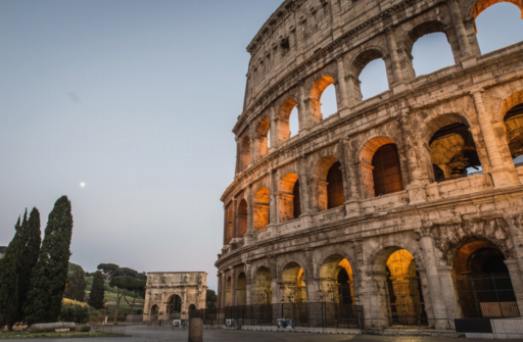During the period known as Pax Romana, which translates to "Roman Peace," the Roman Empire experienced a golden age characterized by remarkable advancements in architecture, engineering, arts, culture, trade, and commerce. This era of relative peace and stability allowed for unprecedented growth and prosperity throughout the empire, leaving a lasting impact on the world that can still be seen and admired today.

Roman Architecture and Engineering during Pax Romana
During the Pax Romana, Roman architecture and engineering reached new heights, showcasing the empire's power and grandeur. The Romans perfected the use of concrete, allowing them to construct massive structures such as the Colosseum, the Pantheon, and aqueducts that spanned vast distances. Architectural elements such as arches, vaults, and domes were commonly used in Roman buildings, creating structures that were not only functional but also aesthetically pleasing.
In addition to their impressive buildings, the Romans also excelled in engineering feats. They built an extensive network of roads that connected the far reaches of the empire, facilitating trade and communication. Bridges, such as the famous Pont du Gard in southern France, demonstrated the Romans' mastery of engineering techniques. They also constructed elaborate public baths, showcasing their understanding of plumbing and sanitation.
The Romans' architectural and engineering achievements during the Pax Romana continue to inspire awe and admiration to this day. Their innovative use of materials and techniques laid the foundation for future architectural and engineering advancements, leaving a lasting legacy of their ingenuity and creativity.
Roman Arts and Culture Flourish in the Golden Age
During the Pax Romana, Roman arts and culture reached new heights and flourished in what is often referred to as the Golden Age of Rome. This period saw an explosion of creativity and innovation in various art forms, from sculpture and painting to literature and music.
One of the most iconic examples of Roman art from this time is the extensive use of realistic sculpture. Artists like Polykleitos and Praxiteles created statues that depicted the human form with incredible accuracy and detail. These sculptures were often used to portray mythological figures, emperors, and important historical events, showcasing the skill and craftsmanship of Roman artists.
In addition to sculpture, Roman painters also made significant advancements during the Pax Romana. Frescoes and mosaics adorned the walls of wealthy Roman homes and public buildings, showcasing intricate designs and vibrant colors. These artworks often depicted scenes from daily life, mythological stories, and historical events, providing a glimpse into the culture and beliefs of the Roman people.
Literature also thrived during this period, with famous writers like Virgil, Ovid, and Horace producing timeless works that are still studied and admired today. These poets and authors explored themes of love, politics, and philosophy, contributing to the rich tapestry of Roman literature.
Music and theater were also important forms of entertainment during the Pax Romana, with elaborate performances and musical compositions captivating audiences across the empire. The Roman love for spectacle and entertainment is evident in the construction of massive amphitheaters like the Colosseum, where gladiator fights and chariot races were held to entertain the masses.
Overall, the arts and culture of Rome during the Pax Romana reflected the empire's wealth, power, and sophistication. It was a time of great creativity and achievement, with artists and scholars pushing the boundaries of what was possible in their respective fields. The legacy of Roman art and culture from this period continues to inspire and influence artists and thinkers around the world today.
Trade and Commerce in the Roman Empire
Trade and commerce played a crucial role in the success and expansion of the Roman Empire during the period of Pax Romana. The Romans were skilled traders and merchants who developed a vast network of roads, sea routes, and markets that connected their vast empire.
The Roman Empire spanned three continents, which allowed for a diverse range of goods to be traded throughout the empire. Luxury items such as spices, silk, and precious metals were imported from distant lands such as India and China, while commodities like grain, wine, and olive oil were exported from Roman territories.
The Romans established a system of currency that facilitated trade and commerce within the empire. The use of coins made transactions more efficient and standardized, allowing merchants to conduct business across vast distances.
The Roman government also played a significant role in promoting trade by ensuring the safety and security of trade routes. The establishment of a common legal system and the presence of a strong military force helped to protect merchants and their goods from bandits and pirates.
The Pax Romana period saw an increase in economic prosperity as trade flourished throughout the empire. The Roman economy was fueled by the exchange of goods and services, which in turn led to the growth of industries and the development of urban centers.
Overall, trade and commerce were essential components of the Roman Empire's economic success during the period of Pax Romana. The Romans' sophisticated trading networks and thriving markets allowed for the exchange of goods and ideas, contributing to the empire's prosperity and power.
Pax Romana: A Time of Relative Peace and Stability
Pax Romana, also known as Rome's Golden Age, was a period of relative peace and stability that lasted for over two centuries. This time of tranquility allowed for unprecedented economic prosperity, cultural flourishing, and technological advancements within the Roman Empire. The peace that Pax Romana brought about enabled Rome to focus on internal development and expansion, rather than constant warfare with neighboring territories. As a result, the empire experienced a period of growth and innovation that left a lasting impact on the ancient world.
